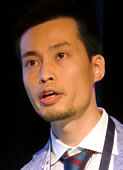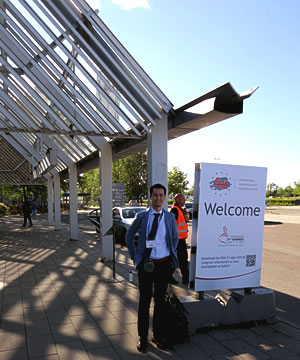21st EHA Congress Travel Award 受賞レポート 前田 卓也

名前:前田 卓也【京都大学 再生医科学研究所 再生免疫学分野、医学研究科 血液・腫瘍内科学】
発表日時:2016年6月11日
発表形式:口頭
Title:
Regeneration of WT1 specific CTLs utilizing iPSC technology
Authors:
Takuya Maeda1,2, Seiji Nagano1,2, Kyoko Masuda1, Toshio Kitawaki2, Akifumi Takaori-Kondo2, Hiroshi Kawamoto1
Affiliations:
1Department of Immunology, Institute for Frontier Medical Science, Kyoto University
2Department of Hematology and Oncology, Graduate school of Medicine, Kyoto University
Abstract:
Background
Current cancer immunotherapies mainly aim to activate and expand tumor antigen specific cytotoxic T lymphocytes (CTLs) in vitro or in vivo, but these methods are not so successuful because of the difficulty in preparing sufficient number of CTLs.
Aims
For successful cancer immunotherapy, we are trying to expand tumor antigen specific cytotoxic T lymphocytes (CTLs) by utilizing the iPS cell technology. When iPSCs are produced from antigen specific T cells, the rearranged configurations of T cell receptor (TCR) genes are inherited to the iPSCs, and when T cells are regenerated from such iPSCs, all of them should come to express the same TCR as the original one. Therefore it will become possible to obtain de novo generated tumor specific CTLs almost unlimitedly. In line with this concept, we have succeeded in regenerating MART-1 specific T cells (Vizcardo et al, Cell Stem Cell, 2013).
Methods
We firstly established iPSCs from CTLs specific for WT1, expanded from healthy volunteers. CD4/8 DP cells were generated by culturing these T-iPSCs on Op9/DLL1 cells. By stimulating these DP cells by agonist peptide or anti CD3 Ab, CD8 T cells expressing CD8 alpha-beta heterodimers were formed. They can be expanded more than ten thousand fold by repeated TCR stimulation.
Results
Regenerated CD8 T cells exhibited very high antigen specific killing activity comparable to the original CTLs and were able to kill some leukemia cell lines and primaly leukemia cells which express endogenous WT1 protein and HLA A2402. In in vivo leukemia treatment model regenerated CD8 T cells elongated the survival of treated mice.
Conclusion
We have succeded in regenerating CD8 T cells with high antigen specific cytotoxic activity. This method could bring about a breakthrough in cancer immuno-therapy.
EHA2016参加レポート
この度EHA travel awardをいただき、6月9日から12日にデンマークのコペンハーゲンで開催された21th EHA congressに参加してまいりました。コペンハーゲンは緯度が高く、6月は最も日が長い時期で、夜の10時過ぎまで明るく、滞在中は天候にもめぐまれました。街も非常にきれいで、歴史的な建築物と近代的なビルとがすばらしく調和がとれていました。会場のBella centerはやや郊外に位置しておりますが、街の中心から地下鉄で10分程度と非常に便利でした。会場はガラス張りの中庭を中心に大小のホールや部屋が集まり、すばらしい会場でした。
今回わたくしは、「iPS細胞技術を用いたWT1特異的CTLの再生」という演題で発表してまいりました。今回のEHAでもCAR-T細胞療法をはじめとする免疫療法は大変注目されており、企業主催のサテライトセミナーを中心に多くの講演がありましたが、一方一般演題では免疫療法の演題はまだ数が少ない状況でした。おそらく演題数が少ないこともあり、幸運にも口頭発表させていただきました。発表自体は問題ありませんでしたが、おそらくiPS細胞を用いてがん抗原特異的T細胞を増やすという話が斬新すぎたのか、Discussionはやや盛り上がらなかったのが少し残念ではありました。CAR-T細胞以外の養子免疫療法がまだヨーロッパではそれほど知られていないのだなという印象を受けました。
その他の講演については、特に診断・リスク分類および治療効果のモニタリングに関して新しい知見が多数報告されていました。特に、AMLやALLの遺伝子異常に関するStudyではよく知られたFLT3の異常やNPM1の異常のみならず、様々な遺伝子異常によるリスクの層別化がなされていました。また治療早期のMRD検出がその後の予後に大きく関係することが明らかにされていました。結果としてはとても当たり前ではありますが、それを多数の検体できっちり示されておりました。また特にALLの領域では、MRDを検出するために免疫グロブリンやT細胞受容体遺伝子を次世代シークエンサーを用いて解析する方法の一般化を目指した報告がありました。
今回のEHAに参加し、残念ながら日本の存在感というのは出せていないなと印象を持ちました。臨床研究とくに治療研究においては米国の力が圧倒的で、ヨーロッパ各国は診断学や基礎研究で存在感を発揮しておりましたが、その中で我々がどうすべきなのか、考えていく必要を痛感しました。
今回の学会に参加し、新しい知見をえたと同時に、Globalな視点で考えることの大事さを感じることができました。大変貴重な機会をいただき、日本血液学会の担当の先生方、理事の先生方、および事務局の方々に大変感謝しております。
